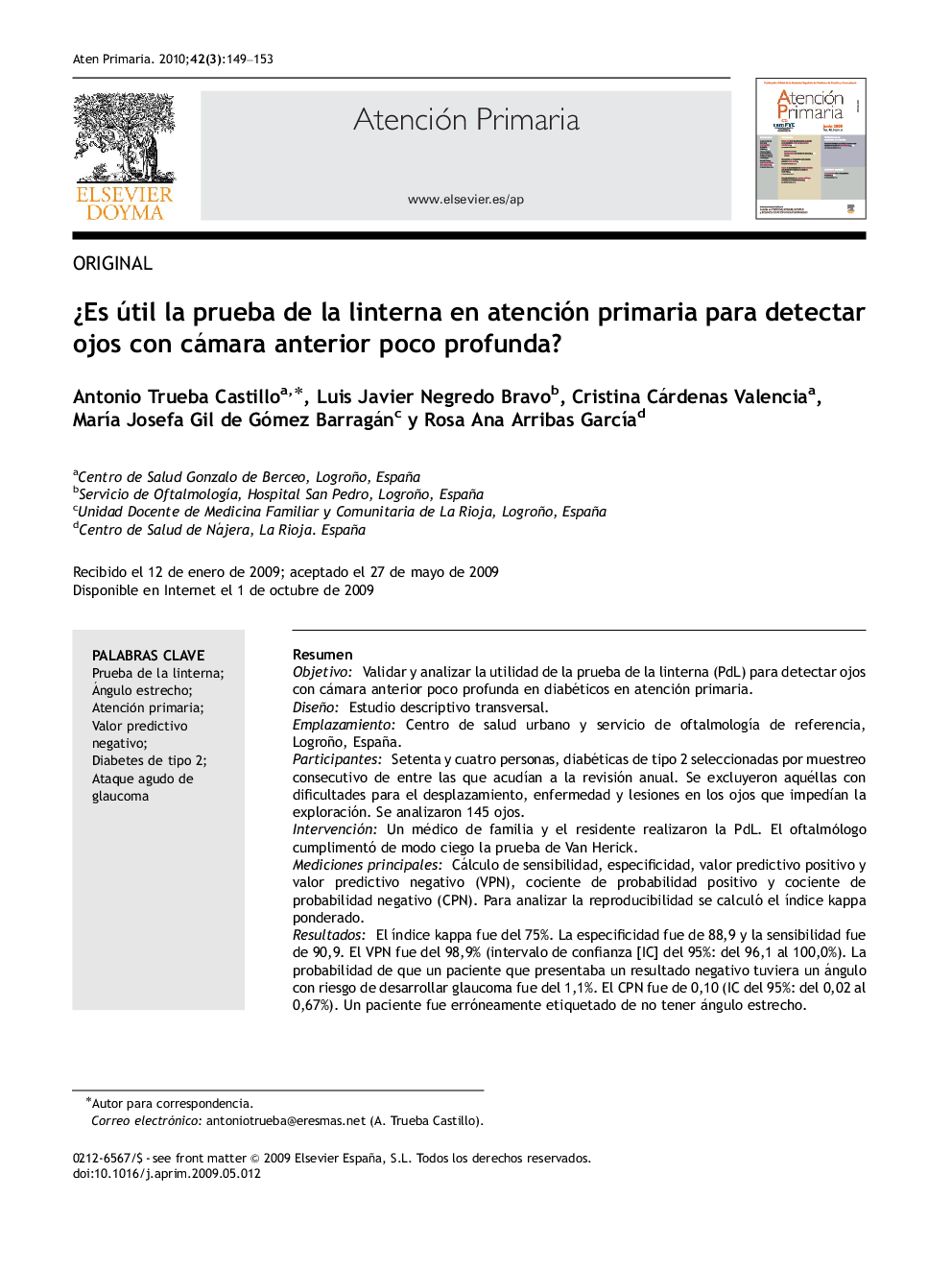| کد مقاله | کد نشریه | سال انتشار | مقاله انگلیسی | نسخه تمام متن |
|---|---|---|---|---|
| 3458194 | 1230957 | 2010 | 5 صفحه PDF | دانلود رایگان |

ResumenObjetivoValidar y analizar la utilidad de la prueba de la linterna (PdL) para detectar ojos con cámara anterior poco profunda en diabéticos en atención primaria.DiseñoEstudio descriptivo transversal.EmplazamientoCentro de salud urbano y servicio de oftalmología de referencia, Logroño, España.ParticipantesSetenta y cuatro personas, diabéticas de tipo 2 seleccionadas por muestreo consecutivo de entre las que acudían a la revisión anual. Se excluyeron aquéllas con dificultades para el desplazamiento, enfermedad y lesiones en los ojos que impedían la exploración. Se analizaron 145 ojos.IntervenciónUn médico de familia y el residente realizaron la PdL. El oftalmólogo cumplimentó de modo ciego la prueba de Van Herick.Mediciones principalesCálculo de sensibilidad, especificidad, valor predictivo positivo y valor predictivo negativo (VPN), cociente de probabilidad positivo y cociente de probabilidad negativo (CPN). Para analizar la reproducibilidad se calculó el índice kappa ponderado.ResultadosEl índice kappa fue del 75%. La especificidad fue de 88,9 y la sensibilidad fue de 90,9. El VPN fue del 98,9% (intervalo de confianza [IC] del 95%: del 96,1 al 100,0%). La probabilidad de que un paciente que presentaba un resultado negativo tuviera un ángulo con riesgo de desarrollar glaucoma fue del 1,1%. El CPN fue de 0,10 (IC del 95%: del 0,02 al 0,67%). Un paciente fue erróneamente etiquetado de no tener ángulo estrecho.ConclusionesLa PdL es válida y útil en diabéticos tipo 2 para descartar cámara anterior poco profunda. Es una prueba sencilla e inocua que puede ayudar al médico de familia a tomar una decisión sobre la midriasis farmacológica para observar el fondo de ojo.
ObjectiveTo validate and analyse the usefulness of the flashlight test (FT) in detecting eyes with a shallow anterior chamber in diabetic patients in primary care.DesignCross-sectional descriptive study.SettingUrban health centre and a reference ophthalmology department, Logroño, Spain.ParticipantsA total of 74 patients with diabetes type 2, selected by consecutive sampling from those seen for an annual check-up. Those patients with movement difficulties, diseases and lesions of the eye, which would hamper the examination, were excluded. A total of 145 eyes were analysed.InterventionA family doctor and the resident performed the FT. The ophthalmologist carried out the Van Herick test without knowing the results of the FT.Primary outcomesSensitivity, specificity, positive and negative predictive values, and positive and negative likelihood ratios were calculated. The reproducibility was calculated using weighted kappa index.ResultsThe kappa index was 75%. The specificity was 88.9% and the sensitivity was 98.9% (95% confidence interval (95% CI) 96.1–100.0%). The likelihood that a patient had a negative result could have an angle with a risk of developing glaucoma was 1.1%. The negative likelihood ratio (NLR) was 0.67%. One patient was incorrectly labelled as not having a narrow angle.ConclusionsThe FT is valid and useful for ruling out shallow anterior chamber in type 2 diabetics. It is a simple and innocuous test that can help the family doctor make a decision on pharmacological mydriasis to observe the back of the eye.
Journal: Atención Primaria - Volume 42, Issue 3, March 2010, Pages 149–153